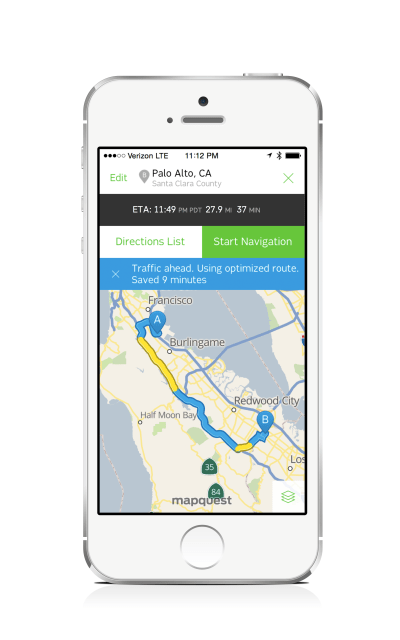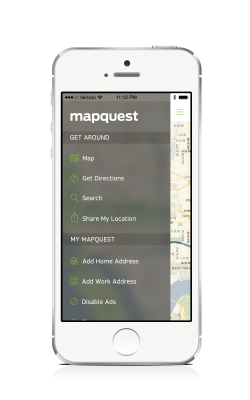On the iPhone, Apple Maps and Google Maps app have gotten all the headlines over the last several years, but MapQuest is still hanging in there, despite a lack of real innovation over the years. Today, the company is unveiling a huge update to its mobile app for iOS that provides a beautiful new alternative to the incumbents.
According to comScore, MapQuest still has the #3 mobile app and is the #2 map service for desktop users. Altogether, it had more than 40 million monthly uniques in September, including 30.7 million on desktop and 14 million on mobile and tablet. It also had 4.3 million multiplatform users — those who used both desktop and mobile. (MapQuest, which is a part of AOL*, says that if its traffic was broken out from the parent company, it would be a top-35 web property all by itself.)
But the MapQuest team thinks it can do better. In fact, it knows it can. So it went back to the drawing board and completely reimagined what its mobile app should look like and how it should work.
The updated MapQuest app is designed to be faster, more responsive, and a whole lot easier to use than previous versions. The team completely redid its cartography, making streets easier to delineate and directions easier to follow. The app has adopted iOS 7’s flat design concept and simplified fonts.
It’s also clearly marked different types of streets by color, following an example set by old-school paper maps. Highways are designated with thick blue lines, main arteries are shown in yellow, and arrows have been added to one-way streets.
A lot of the changes are purely cosmetic, but under the hood MapQuest rebuilt its mapping stack from the ground up. That allows the whole thing to render really quickly, without having to load a bunch of tiles each time the app is opened. Once opened and used, maps are cached so that users can come back and load them later on, even when they’re offline.
 Navigation has also been greatly improved: Now when you enter a location and begin your journey, the app displays a slider at the top of the route to clearly show how far along you are, along with an estimate for your arrival and how much time you have left. The app also shows areas where you can expect to see traffic, which is displayed in yellow and red.
Navigation has also been greatly improved: Now when you enter a location and begin your journey, the app displays a slider at the top of the route to clearly show how far along you are, along with an estimate for your arrival and how much time you have left. The app also shows areas where you can expect to see traffic, which is displayed in yellow and red.
With real-time traffic data, the app can also automatically re-route users when it sees an opportunity to save them time by using a different route. In those cases, a notification pops up to alert them of the change, before counting down and beginning to display new directions.
While many people will use the app mostly for navigation, MapQuest has also added a lot of local discovery features, allowing users to quickly find categories of businesses nearby really quickly. More importantly, they can go beyond just seeing nearby restaurants, bars, and cafes, to being able to define and highlight the categories that are most important to them.
With one click, coffee addicts will be able to add Starbucks to their discovery field and instantly see where the nearest location of the coffee chain is. Or vegan diners will be able to add that category and quickly find nearby restaurant choices that fit their diet.
MapQuest has also refined its search function, combining data from user address books, categories, and locations, blending them all together in a way that is meant to highlight addresses and venues that are most important to them. That could mean the address of their friends, or locations that feature prominently among searches from other MapQuest users. And if a chain restaurant or a category of venue is searched for, the app will be able to show all nearby locations on the map.
Due to the flatness of the design, the new MapQuest app will only be available for users who have already upgraded to iOS 7. And for now, much of the venue and navigation data is limited to North American users only. Still, for those who have access to it, the new app is a huge step forward, and users might even find that they prefer it to the competition.
==
* AOL also owns TechCrunch, although sometimes the company might regret it.
